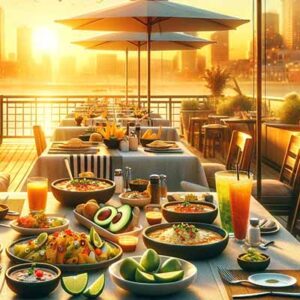Edible Art - Creating Awe-Inspiring Japanese Sweets - Henderson Edition
2024.9.9
by Min Kim
Japanese Cuisine
While Japanese cuisine became famous for its taste and texture, it also balances with aesthetic views, there are many kinds of dishes, each of which reflects a piece of cultural history. One of the special desserts is called wagashi or Japanese sweets. They are not just desserts; they are a work of art in edible form, made with great attention to detail. This article looks at the history behind beautiful Japanese sweets, their types, and cultural significance.
Originated from the Nara period, between 710 and 794 AD, with the importation of sugar from China, this development of wagashi as an art really picked up during the Edo period-from 1603 to 1868. It was in this period of peace and prosperity, when the cultural mood prevailed, it evolved as an art influenced by the tea ceremony. It was made to suit the taste of matcha bitter, but at the same time, it looked very colorful according to different seasons. Types of Wagashi

Wagashi are prepared in an assortment of shapes, colors, and flavors. In fact, each of them reflects some other aspect of the culture and nature of Japan. The following are a few of the common types of wagashi usually served:
1. Namagashi: These are fresh sweets usually made from sweetened red bean paste and wrapped up with a layer of soft mochi. Many namagashi exist which are famous for their detailed designs, mostly flower, bird, or seasonally shaped.
2. Manjū: These are steamed buns filled with sweet bean paste. Manjū usually take a round shape, but they may take any form, from animals down to fruits.
3. Dango: Sweet dumplings made with rice flour. Typically, dango are skewered and can range in anything from sakura flavored hanami dango to soy glazed mitarashi dango.
4. Yokan: This is a jellied dessert made using red bean paste, sugar, and agar. Yokan has a variety of flavors which could be induced into it, such as matcha and chestnuts, and its smooth firm texture makes it a favorite among all lovers of wagashi.
This laborious process needs an artistic eye, patience, and skill for making wagashi. The whole work begins with preparation of sweet bean paste, usually from azuki beans. The paste is colored and shaped to form the right design.
Exotic wagashi as such is closely connected with the change of season. Colors, shapes, and flavors stand for the seasonal motifs, starting with the spring cherry blossoms and ending with the autumn maple leaf. All this expresses the Japanese interest in nature and the movement of the time.
Wagashi is an important cultural element in Japan, closely combined with the Japanese tea ceremony and festivals for every season. It is also a pleasure not only for the tongue but also for the eyes, representing Japanese aesthetics of simplicity, subtlety, and congruity with nature.
During the tea ceremony, wagashi is used as a balance to the bitterness of matcha for a harmonious pairing. Sweets are also a common token of celebration and festivity, to wish well and show hospitality.
With their whimsical design and subtle fragrances, wagashi embodies Japan’s food as both an art and a craft. They reflect the nation’s cultural values from an appreciation of nature and its seasons to a pursuit of harmony and balance.
Further still, as we journey into this world through the things it eats, remember all dishes and ingredients have a story. The story of wagashi is one of those stories, a narrative which affords a peek into the heart of Japanese culture and aesthetics. The next time any of you taste a piece of wagashi, let your mind follow the journey of this edible art from the craftsman’s hand onto your plate.
1stHendersonGuide.com

We List Only the Best
1st Henderson Guide is not a list of every business. Our website highlights only the best businesses / places / events are featured within these pages. This makes Henderson even more magical for residents and visitors alike.

Advertise Your Company
You can be seen by a high quality audience when you place an advertisement on 1st Henderson Guide. Not all companies are accepted… Call 702-445-9488 to be have your company seen by affluent buyers. You will be amazed how with the low price.

1st City Guide Expansion
1stCityGuide.com is the parent company of 225+ city guides worldwide. We are expanding and looking for Licensee partners to work together and provide a quality income when sharing the secrets of great cities around the world with visitors and residents alike. Call 702-210-4201 to discuss pricing and city guide availabilities.
